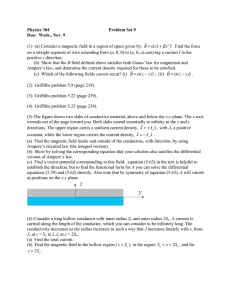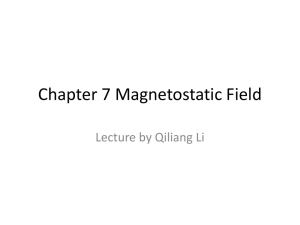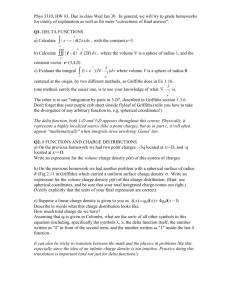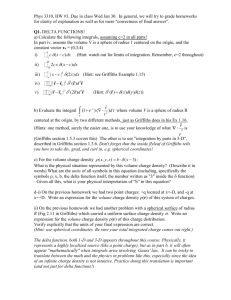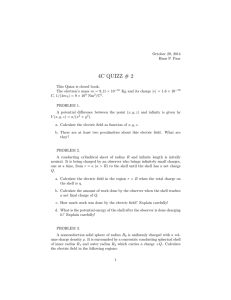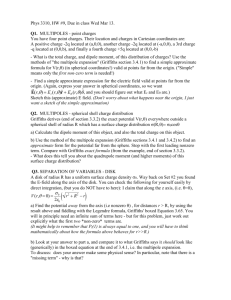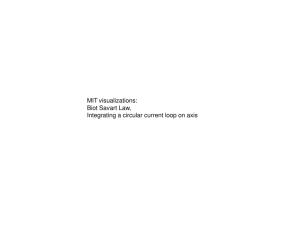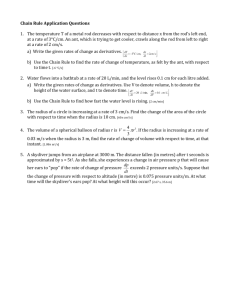HW12
advertisement
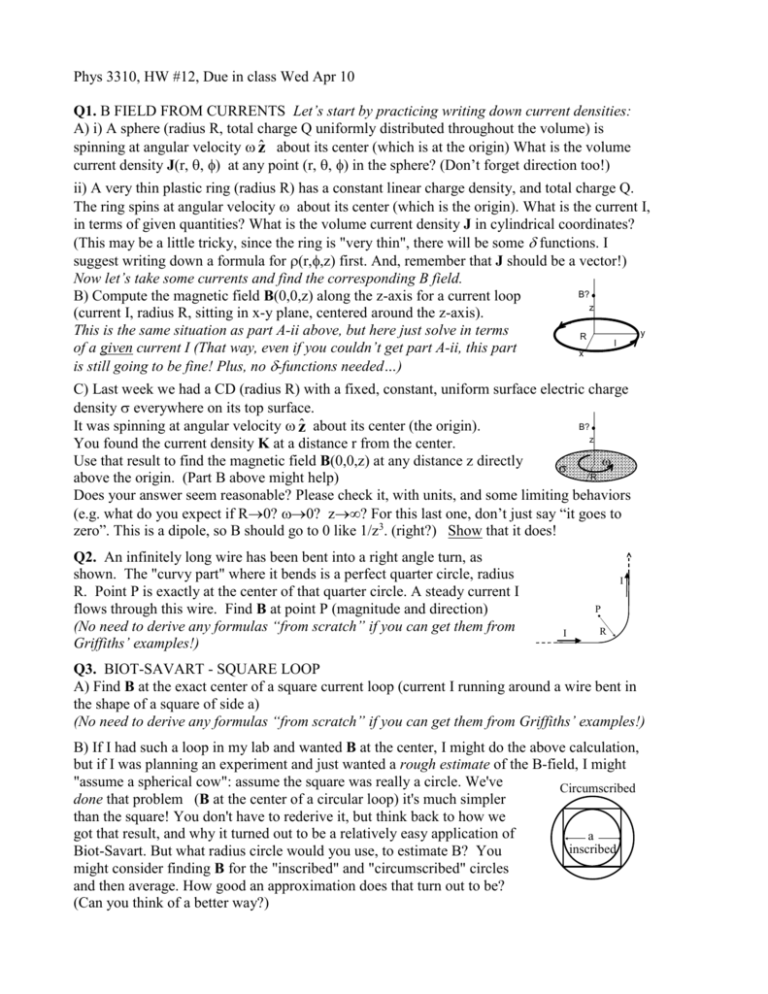
Phys 3310, HW #12, Due in class Wed Apr 10 Q1. B FIELD FROM CURRENTS Let’s start by practicing writing down current densities: A) i) A sphere (radius R, total charge Q uniformly distributed throughout the volume) is spinning at angular velocity zˆ about its center (which is at the origin) What is the volume current density J(r, , ) at any point (r, , ) in the sphere? (Don’t forget direction too!) ii) A very thin plastic ring (radius R) has a constant linear charge density, and total charge Q. The ring spins at angular velocity about its center (which is the origin). What is the current I, in terms of given quantities? What is the volume current density J in cylindrical coordinates? (This may be a little tricky, since the ring is "very thin", there will be some functions. I suggest writing down a formula for(r,,z) first. And, remember that J should be a vector!) Now let’s take some currents and find the corresponding B field. B? B) Compute the magnetic field B(0,0,z) along the z-axis for a current loop z (current I, radius R, sitting in x-y plane, centered around the z-axis). This is the same situation as part A-ii above, but here just solve in terms y R I of a given current I (That way, even if you couldn’t get part A-ii, this part x is still going to be fine! Plus, no -functions needed…) C) Last week we had a CD (radius R) with a fixed, constant, uniform surface electric charge density everywhere on its top surface. B? It was spinning at angular velocity zˆ about its center (the origin). z You found the current density K at a distance r from the center. Use that result to find the magnetic field B(0,0,z) at any distance z directly w s R above the origin. (Part B above might help) Does your answer seem reasonable? Please check it, with units, and some limiting behaviors (e.g. what do you expect if R0? 0? z? For this last one, don’t just say “it goes to zero”. This is a dipole, so B should go to 0 like 1/z3. (right?) Show that it does! Q2. An infinitely long wire has been bent into a right angle turn, as shown. The "curvy part" where it bends is a perfect quarter circle, radius R. Point P is exactly at the center of that quarter circle. A steady current I flows through this wire. Find B at point P (magnitude and direction) (No need to derive any formulas “from scratch” if you can get them from Griffiths’ examples!) I P I R Q3. BIOT-SAVART - SQUARE LOOP A) Find B at the exact center of a square current loop (current I running around a wire bent in the shape of a square of side a) (No need to derive any formulas “from scratch” if you can get them from Griffiths’ examples!) B) If I had such a loop in my lab and wanted B at the center, I might do the above calculation, but if I was planning an experiment and just wanted a rough estimate of the B-field, I might "assume a spherical cow": assume the square was really a circle. We've Circumscribed done that problem (B at the center of a circular loop) it's much simpler than the square! You don't have to rederive it, but think back to how we got that result, and why it turned out to be a relatively easy application of a inscribed Biot-Savart. But what radius circle would you use, to estimate B? You might consider finding B for the "inscribed" and "circumscribed" circles and then average. How good an approximation does that turn out to be? (Can you think of a better way?) Phys 3310, HW #12, Due in class Wed Apr 10 +z K +y +x Q4. AMPERES LAW - THEMES AND VARIATIONS Consider a thin sheet with uniform surface current density K 0 xˆ A) Use the Biot-Savart law to find B(x,y,z) both above and below the sheet, by integration. Note: The integral is slightly nasty. Before you turn to Mathematica - simplify as much as possible! Set up the integral, be explicit about what curly R is, what da' is, etc, what your integration limits are, etc. Then, make clear mathematical and/or physical arguments based on symmetry to convince yourself of the direction of the B field (both above and below the sheet), and to argue how B(x,y,z) depends (or doesn't) on x and y. (If you know it doesn't depend on x or y, you could e.g. choose x=y=0 to simplify... But first you must convince us that's legit!) B) Now solve the above problem using Ampere's law. (Much easier than part a, isn't it?) Please be explicit about what Amperian loop(s) you are drawing and why. What assumptions (or results from part a) are you making/using? (Griffiths solves this problem, so don't just copy him, work it out for yourself!) C) Now let's add a second parallel sheet at z=+a with a current running the other way. (Formally, this means J'=- K 0 d(z - a) xˆ . Do you understand this notation?) Use the superposition principle (do NOT start from scratch or use Ampere's law again, this part should be relatively quick) to find B between the two sheets, and also outside (above or below) both sheets. Does this remind you of a familiar electrostatics problem at all? How? D) Griffiths derives a formula for the B field from a solenoid (Example 5.9) Rewrite his answer (which is in terms of I) so it is expressed in terms of K (See his Fig 5.34 and 5.35 for help with this) Briefly compare with part C, do you see any rough connections? Q5. AMPERE'S LAW-II Now the sheet of current has become a thick SLAB of current. +z The slab is infinite in (both) x and y, but finite in z. +y So we must think about the volume current density J, rather than K. 2h J +x The slab has thickness 2h (It runs from z=-h to z=+h) Let's assume that the current is still flowing in the +x direction, and is uniform in the x and y dimensions, but now J depends on height linearly, i.e. J =J0 | z | xˆ inside the slab (but is 0 above or below the slab). Find the B field (magnitude and direction) everywhere in space (above, below, and also, most interesting, inside the slab!) Q6. UNIFICATION A) Two very long straight line charges (linear charge density ) are a distance d apart. Both move to the right at constant speed v. How big does v have to be so that the magnetic attraction exactly balances the electric repulsion? Find the actual number, and comment! (Note: there are no special relativity complexities or issues here at all: v and are measured in the lab frame) l v d l v B) Along with the necessary addition made by Maxwell, Ampere’s law in full glory reads . Take the divergence of this equation, and derive the continuity equation (Eq 5.29 in Griffiths section 5.1.3) You have just derived the conservation of electric charge! I think both these results are pretty cool, and carry very deep messages about the nature and unification of electricity and magnetism, and their connection to special relativity!
